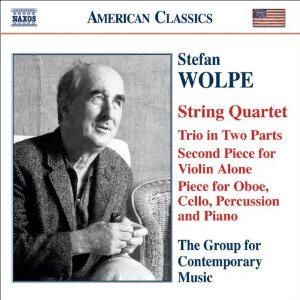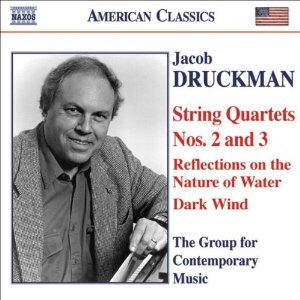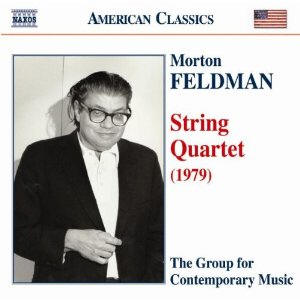|
You are reading the older HTML site
Positive Feedback ISSUE 56
Notes of an Amateur: Wolpe, Druckman,
and Feldman
Stefan Wolpe, String Quartet; Trio in Two Parts for Flute, Cello, and Piano; Second Piece for Violin Alone; Piece for Oboe, Cello, Percussion, and Piano. The Group for Contemporary Music. Naxos 8.559262. It is tempting for a writer about music to group the works of Stefan Wolpe, Charles Wuorinen, Milton Babbitt, Morton Feldman, and Jacob Druckman, the so-called New York School of modernism, both with one another and with their contemporary painters, the Abstract Expressionists, also centered, at least in the critical imagination, in New York. It also tempting to do this as an amateur listener (and looker). It is a shortcut to bearings, which this music and art intentionally leave us somewhat without. But if you can do without the comfort of bearings, it is arguably better to let works of music and art make their own case, have their way with us, create their own bearings. At least to begin with. I do this especially with radically modernist music when I can. It really is the only way to really hear or begin to get what's going on, rather than account for it, which is a secondary, intellectual matter, yes? Stefan Wolpe's music sketches out a sensibility, rather than narratives or ideas, made up of vigorously drawn diagonal lines (String Quartet, 1968-69) or bold and brilliant splashes of tonal color (Trio,1964; Piece, 1954)). Like most of the music of this group of composers, it offers an experience less susceptible to being followed than pre-modernist music. It presents a less intellectually coherent view of the world and places us in it. This is its modernism. We are meant to stay in its presence—especially in time—the music does not audibly refer to, echo, or build upon the history or tradition of music in which it now, fifty years later, nevertheless sits! It is music designed (presumably) to free us from that, presumably for the better. The experience of listening to it, if we are receptive, is a bracingly liberating one. If we enjoy that, the music works. It we don't, the music resists us, we resist it. That is also its modernism. Modernism in its most radical forms aims to address us directly, to go around our inherited musical expectations. At its best, and Wolpe is one of the best, it achieves this feeling of a re-birth, of a fresh beginning for music. Fifty years later it still has the power to induce us to disregard the tradition, the context of music history, and just listen, just be, here, now. If you value a sense of continuity and context in music (and art) history, this music may feel alienating, even sophomoric. I do but it's not, though I've been known to accuse some other avant-garde composers of losing track of what music is. One test of the success of this music is how it feels when you return to traditional music. It may well feel as disorienting as when you came here! But then what happens, after the initial shock of re-entry, is that we begin to hear the 'old' music as timeless sound too. It sounds a bit new, at least for a while, until the inherited tide rolls back into our heads. So not only does radical modernism at its best effectively win us to a new musical world, it can also refresh our palette for the old one. Okay, sorry not be more specific about Wolpe's works here, I'll focus more closely with Druckman's.
Jacob Druckman. String Quartets Nos. 2 and 3. Reflections on the Nature of Water. Dark Wind. The Group for Contemporary Music. Naxos 8.559260 Jacob Druckman is far less intense than Wolpe but shares his abstract sensibility. Quartet No. 3 (1981) is playful, discontinuous in mood and line, and blessedly lacking in intensity, with a tendency to double back on itself and smile. Whimsical. Full of counterpoint and instrumental exchange, conversation. Sometimes he sounds like a musical grandson of Charles Ives. We often feel we are listening to notes sketched for a work written back when longer, continuous works were more viable. There is a refusal to complete musical ideas. We are not invited to put it all together but simply to 'look' at it, enjoy its musical antics. Much of the pleasure here is in listening to stringed instruments stretch their wings, dance new steps. As with the Wolpe works but without their intensity, we are asked to just dwell in a sonic landscape whose charms have very little to do with coherence. Don't ask, just listen. Reflections on the Nature of Water (1986), a work for solo marimba and played with virtuosity by the composer's son, Daniel Druckman, has these same qualities but is striking for having a singular instrumental voice, though the marimba is a considerably more various sounding instrument that you might think. As the album notes point out, there is a distinctly Japanese flavor to the Reflections but it has clearly been imported to the West. We are in and out of Dark Wind (1994), a short and eloquent duo for violin and cello, before we know it, but it leaves strong impressions. I expect it has been used often as a successful encore piece, as its effect is to leave little more to be said! String Quartet No. 2 (1966), a work in one movement, features hints of melodrama and more instrumental calisthenics, but is still more pranksome than intense or passionate. We get the sense from this quartet that Druckman wanted us to hear the instruments 'becoming,' taking on their individual timbrel identities.
Morton Feldman, String Quartet (1979) . Group for Contemporary Music. Naxos 8.559190. Morton Feldman is the boldest of the abstract impressionist modernists, unless we consider his over the wall and across the field friend, John Cage. He takes us farther out (or in) than many of us are willing to go, stripping music down to its barest sonic bones. He asks us, in the case of this string quartet, to sit still for 78 minutes while four stringed instruments etch with sublime gentleness tiny figures on a huge silent canvas, the only structure provided by a sense of breaths between them. The only way to perceive this music as anything at all is, as with religious faith, to surrender to it, suspend disbelief and let grace come, if it will. For what it's worth, grace came for me around 59 minutes in, though I couldn't swear to it. It could have been the Scotch. Fifteen minutes in, we have the shock of an extended musical phrase and then, after a return to discrete notes, another one. These surprises and others come to feel like musical oases. At twenty minutes, we get several forte sound blasts from the whole quartet and then a return to the single notes and chords. In their effect, these oases are events which mark the landscape, which eventually becomes as much an image of time as of space. They recur in various forms throughout the work, sometimes minimal phrases which last 8-10 seconds, sometimes mellifluous splashes of sound. There is really little more to say about such a work in and of itself. I write here mainly to draw attention to it for those unfamiliar with Feldman's music. It does, to me, mark or occupy a boundary on the outer (or inner) edge of what we may comfortably call music, just as some abstract expressionist paintings do for their art. Paintings have the advantage, some might say, of being framed, of having endings—and so shape. A frame brings the comfort of closure. We know, we can see, when the painting (or story or quartet) is over. Feldman's music ends but we have the sense that it could just as well have gone on. Forever. Feldman resists endings as much as he resists internal form and has conceded that he sometimes just "lets things go." He clearly has issues with the boundary between art and reality, knows he's out there close to the edge. And again, this is the issue with his music. Bringing form to our formless existence is the principal way art has always made its case for its existence. There needs to be a difference or why bother! Feldman has found an audience, so I feel some confidence in not saying his music is beyond the boundary. But he does test us: he does ask us to consider how music can be radically different from what we know, and I find that a useful thing to have done. There are doubtless some who will call this music an 'aid to reflection or meditation' and thus not intended to stand alone as a work of art. And there are likely even more who consider it across the boundary of art and reality and into a non-musical realm of spirituality. I have some sympathy with this tack but in the end find it evasive or defensive. Art is not spirituality. This is music or it's silly and pointless noise. There is no New Age. All three of these albums were originally issued by Koch Schwann in the 1990's. The sound is absolutely superb, thanks presumably to recording engineer Judith Sherman, who has a considerable reputation for getting things extraordinarily right. Her skills are essential to the Feldman quartet. Many thanks to Naxos for getting these recordings back into circulation. System used for this audition: Audio Note CDT3 transport; Blue Circle BC501ob LOC dac, BC 3000II GZpz preamplifier, and BC204 KQ amplifier. JM Reynaud Orféo Supreme speakers. Audio Note cable. Bob Neill, in addition to being an occasional equipment and regular music reviewer for Positive- Feedback Online, is also proprietor of Amherst Audio in Amherst, Massachusetts, which sells equipment from Audio Note, Blue Circle, and JM Reynaud, among others.
|



